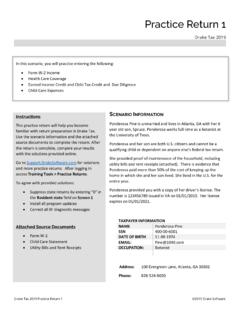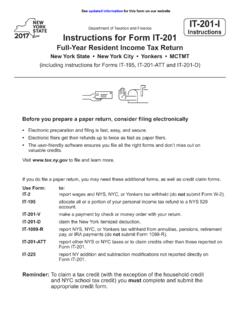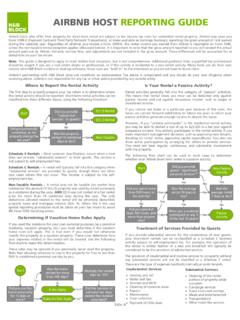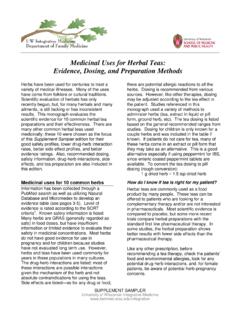Transcription of Experiment 5 (Lab Periods 5 and 6) Gel Electrophoresis. In
1 Experiment 5 (Lab Periods 5 and 6) Gel electrophoresis A common method of analysis in molecular biology is Gel electrophoresis . In general, gel electrophoresis is a process by which the macromolecules within a sample are separated from one another on the basis of size. The process can be applied to different types of macromolecules such as proteins and nucleic acid (DNA and RNA). In this lab you will use gel electrophoresis to determine whether or not the fragment of DNA that you amplified by PCR in Experiment 4 is the expected size. Although this will not constitute absolute proof, if the fragment present in your reaction tube is the correct size it will strongly suggest that your PCR worked.
2 The basic idea behind gel electrophoresis is that you will force the macromolecules through a porous matrix (the gel). The two most commonly used gels are composed of either agarose - which you will use today - or acrylamide (polyacrylamide gels). DNA is forced to move through the matrix by placing the gel in an electric field. DNA molecules have a negative charge so they will flow from the negative pole to the positive pole of the field. The DNA molecules, however, do not flow freely in the field. Instead, the gel acts like a sieve to impede the migration of the DNA molecules, slowing the rate at which they move towards the positive pole. The key to separating DNA molecules is that larger molecules are more strongly impeded by the gel than smaller molecules.
3 As a result, smaller molecules of DNA (those composed of fewer nucleotides) migrate through the gel at a faster rate. After a period of time, the shorter fragments are further from the origin than are the longer molecules. In this manner, DNA fragments in a solution are separated on the basis of size. There are several basic steps to performing gel electrophoresis that will be described below; 1) Pouring the gel, 2) Preparing your samples, 3) Loading the gel, 4) Running the gel (exposing it to an electric field) and 5) Staining the gel. 1. To pour, or prepare, an agarose gel you boil a sample that is typically between and 1% agarose (1% = 1g per 100ml). After it has boiled it is poured into a mold and allowed to cool.
4 After it has cooled it will solidify into a matrix. When the gel is poured into the mold a comb is placed in the mold at one end so that the gel contains several wells. This step will be completed before you come to lab. 2. Preparing your sample means that you add a loading dye to your DNA sample(s). The loading dye serves two purposes. The first is that it allows you to visualize migration of the samples through the gel (the second function will be discussed in step 3). Although you do not see the DNA molecules themselves you can monitor the progress by observing how far the dye (which has a negative charge) has migrated. The most typical dye is bromophenol blue which migrates through a gel at the same rate as a DNA molecule that is 300 nucleotides in length.
5 3. Loading the gel means adding your samples to the gel. The first step is to remove the comb so that you expose the wells. Each sample will be transferred into one of the wells so that it is essentially within the gel itself. The loading dye that you added also contains a sugar which makes the solution fairly dense so that is sinks into the well quite easily. 4. Running the gel refers to exposing it to an electric field. For agarose gels we usually set them somewhere in the range of 20 to 100 Volts (higher than 100 Volts can potentially cause the gel to melt from the heat generated). The higher the current the faster the molecules will migrate and the sooner you can analyze the gel. However, the slower the migration the easier it is to obtain clear results.
6 We usually run an agarose gel until the dye has migrated about halfway from the wells to the end of the gel. 5. Staining the gel refers to staining the DNA molecules so that we can determine how far they migrated from the origin (the wells). Ethidium bromide is the most commonly used stain but it is also a suspected carcinogen so in this lab you will use a blue dye called CaroBlu which is, unfortunately, not as sensitive as ethidium bromide. The stain will bind to DNA and bands will appear on the gel wherever there is DNA. Once it has been stained we can analyze the gel. (Note, the stain is different than the dye from step 2. The dye did not bind DNA, it simply migrated through the gel so that we could monitor progress.)
7 Once the gel has been run and stained we can analyze it. Analysis involves determining the length, in nucleotides, of the DNA molecule(s) in your sample. To do this you will measure how far each molecule has migrated through the gel since this distance is a function of the length of the molecule; smaller (shorter) molecules will migrate further than longer molecules. To determine the size you compare them to a standard. The standard is a sample of various DNA molecules of known size. By measuring the distance migrated for each of the molecules in the standard you can construct a standard curve by plotting size vs distance migrated. However, the distance a DNA fragment migrates is not a linear function of its size.
8 Instead, a molecule which is 1/10th the size of another will not migrate 10 times as far but only twice as far. Therefore, to construct the standard curve you must plot the logarithm of the size of the molecule against the distance migrated. By doing this, the plot will generate a straight line. In this lab the instructor will load a standard into one of the wells that will allow you to construct a standard curve once you have stained the gel. Once you have constructed the standard curve you can determine the size of any other molecules you loaded into other wells of the same gel. To do this you simply measure the distance your molecule has migrated from the well. Using the standard curve you then determine the logarithm of its size.
9 By taking the inverse log you will calculate the size of the molecule, measured in length by the number of nucleotides. In this lab you will use the product of your PCR from Experiment 4. After running this on the gel you will construct a standard curve and determine the size of your PCR product. Procedure The gel will be boiled and poured into the mold before you arrive so that it will be ready to load. Your instructor will prepare the gel by removing the comb to expose the wells and placing the gel into the buffer that will carry the current. Label a 500?l centrifuge tube with your group number. 1. From the tube containing your PCR from last class remove 10?l from underneath the mineral oil (make sure you are not simply withdrawing the mineral oil on top of the reaction!)
10 Transfer this to your labeled tube and add 5?l of Loading Dye. ( return the remainder of your PCR to your instructor. 2. Using the micropipetman load your entire sample into the well indicated by your instructor. 3. Once all samples and the standard have been loaded an electric current will be applied. The time required is at least 2 hours so the gel will run for the remainder of the lab and be analyzed the following week. 4. Measurement. After the gel is run you will see the DNA molecules in the gel that have been stained blue. Measure the distance migrated for every molecule in the standard. In addition, measure the distance migrated by the two molecules in the sample lane that are the farthest from the wells (these will be the 2 smallest molecules in your sample).)

















